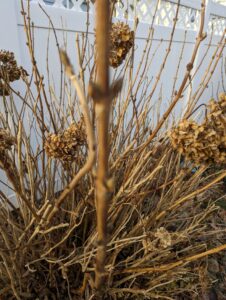 The winter solstice has happened, which means that as each day passes, the western hemisphere gains about one minute of daylight. Of course it will take some time before those daily gains make a difference in daily life. In January and February, storms often obscure the increased daylight, making it harder to pluck hope from the landscape of bare branches.
The winter solstice has happened, which means that as each day passes, the western hemisphere gains about one minute of daylight. Of course it will take some time before those daily gains make a difference in daily life. In January and February, storms often obscure the increased daylight, making it harder to pluck hope from the landscape of bare branches.
But I, like gardeners everywhere, am an optimist—and it is not simply because the garden catalogs have already started drifting into the mailbox. I know things are stirring in the garden, or building energy for the spring extravaganza. In late December and early January, I often put on warm clothes and move through the garden looking for signs of life. They are always present if you know where to look.
Take the bigleaf hydrangeas or Hydrangea macrophylla. I have the old-fashioned kind that bloom on “old” wood, meaning that next spring’s flowers will appear on last summer’s growth. That also means that the shrubs are budded already. When I walk around my messy back garden on cold mornings I can see those buds, nascent, but not yet swollen, projecting from the stalks. I say a silent prayer that an unseasonably warm snap in late winter or earliest spring doesn’t start the swelling process ahead of schedule. Every hydrangea lover knows that when that happens, late frosts will kill those buds, meaning a loss of the beautiful blue flower panicles later on.
For now, though, the buds are a hopeful sign.
When I am on my back garden tour, I always make my way to the Christmas rose, or Helleborus niger to see whether white flower buds have emerged. The plant does not bloom at Christmastime in this part of the world, though occasionally, I have seen the buds on New Year’s Day. Right now, they have not appeared yet, but I will continue to check.
The earliest snowdrops are making a brave show near the back porch. On cold mornings they are bowed, with the flowers nearly touching the ground. As soon as the sun climbs farther into the sky and the temperature notches up a few degrees, they raise themselves from their cold stupor and glow in their small but significant way. I suppose that if they were growing in the milder climate of southern England, they would be called “autumn snowdrops”. Here they are simply one of the first harbingers of the growing season to come.
Both my back and front gardens are home to oakleaf hydrangeas, the relatives of my bigleaf shrubs. They too bloom on old wood, and they bear the buds of next year’s flowers even as the old leaves are finishing the process of leaving the scene. Since I am a lazy gardener, I haven’t yet removed the dried remains of this past summer’s flowers. If anyone asks, I’ll just tell them that I am “rewilding” the garden, which is fashionable right now. If we have a January thaw, I will get at those flowerheads.
Of course those buds, or rather, the branches that support them, also present a dilemma. Oakleaf hydrangeas are enthusiastic growers, and mine have outdone themselves over the course of a mild summer and a rainy fall. The older of my two oakleaf shrubs grows right by the front porch and will completely obscure it unless the branches are pruned. However, pruning will also take out many of those buds, meaning fewer flowers in early summer. Fortunately, inattention usually wins out, as do the flowers. The Amazon and pizza delivery people will just have to guess at my house number.
Possibly the most brilliant sign of life is the ‘Britzensis’ willow or Salix alba ‘Britzensis’. I grow mine in standard form, though it is forever trying to behave like a shrub. The sign of life on the little willow is obvious in the new growth. The bare branches shoot up in glowing red, which is especially striking in the winter light. I can see them from my bedroom window when I get up in the morning, and they give me hope for even the most complicated day. They are also excellent in cut flower arrangements, though the brightness dims a bit after the branches leave the plant.
Just about every world culture has a holiday at the height of the dark months to summon a return to light. My own “festival of lights” happens in ten minute increments when I make the daily search of the garden for hints of new life.
